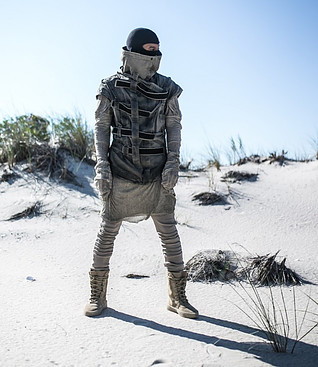
The purpose of clothing in a desert environment is to help reduce fluid loss and provide protection from sunburn. It also has the added benefit of providing warmth at night and being a barrier against insect bites and thorns. Desert clothing should be loose-fitting with an air space between the garments and the body to provide insulation.
As a practical example, copy the free flowing, layered garments of the Arab world. Long pants or trousers provide much better protection from insects than shorts and, of course, protect against serious leg burns if you are forced into daylight exposure. It is just as important to cover the head and feet for the same reasons.
Do not strip off your clothes. As uncomfortable as it may be, an uncovered body will greatly increase the risk of severe sunburn and also lose sweat through evaporation requiring even more fluid to cool it. As mentioned about, keep the covering as loose as possible to permit an insulating layer of air. This will permit sweating to cool you more efficiently.
HeadGear
Any hat with a piece of cloth flowing out of the back will provide protection to both the head and the back of the neck. But, if given an option, it is better to copy the headgear of desert peoples. Let’s face it, they have probably been doing this a lot longer than you and have picked up a few helpful ideas.
To mimic this design you will need a piece of material about 4 ft (120 cm) square, a smaller piece of cloth, like a handkerchief, and a piece of cord or cloth (a neck tie would be ideal) to keep them in position.
Place the handkerchief into a wad on the top of your head. Then, take the large cloth and fold it diagonally, place it over the wadded handkerchief with the long edge facing forward. Tie the cloth or cord around the head to secure them.
If you allow this to flow freely it will protect you from the sun, trap pockets of air, take advantage of any breezes and even protect from sandstorms. At night, wrap it around the face for warmth.
Eye Protection
To protect from the desert sun, sunglasses or darkened goggles may help. However, if they are made for more temperate climates they may provide insufficient protection. To provide additional protection, you can smear soot from your fire underneath your eyes which will reduce the glare reflected from the skin. If these are not available, shield your eyes with a strip of material with narrow slits cut in it that will allow you to see.
Footwear
Do not walk barefoot on hot sand until your feed have been hardened and conditioned to do so. Otherwise, it will burn and cause blisters. If you are in a survival situation in the desert (as with all other survival situations), you want to avoid injuries as much as possible.
In the desert, even the most trivial wound is likely to become infected if not addressed immediately. Thorns are easily picked up from any desert plants – they should be removed immediately. Large and painful sores that can prevent walking could develop in areas where the skin is broken. Bandage all cuts with clean dressings and use whatever medical resources are available to prevent infection.
Do not wear sandals that leave the top of the feet exposed. Do your best to improvise coverings if you don’t have any. Puttees will help keep sand out of your boots. They can also be extended to wrap around the foot over open sandals.